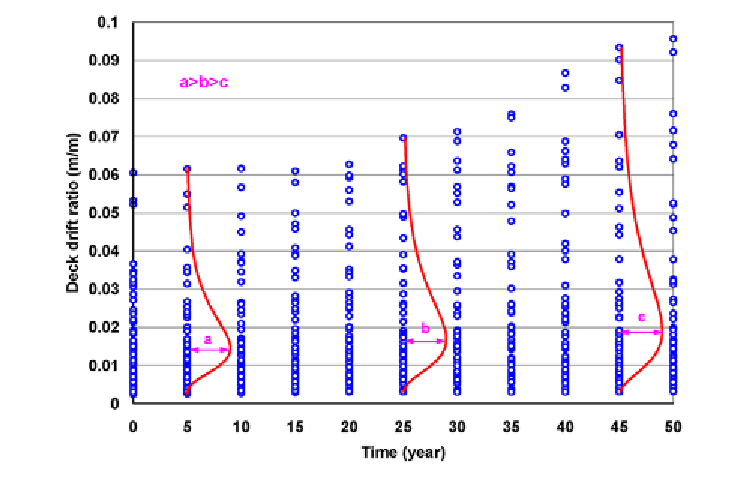Geology Reference
In-Depth Information
Figure 6. The distribution of DDR response over the time for the two-span bridge with the medium span
length and column height of 10 m
C
s
u
, the user cost associated with the probable
service failure. The inflation is also taken into
account by dominating future maintenance ex-
penditures in base year prices. These recurrent
maintenance costs are combined by weighing
them according to a discount factor that takes into
account the time value of the money. The discount
factor,
z
(
t
), is defined as:
resources for design, construction, and operation of
the structure. The focus of the current study is on
the LCC analysis of RC bridges located in extreme
chloride-laden environments. From the resources
point of view, it is important to optimize the inspec-
tion and maintenance schedules in a way so that
the total cost of structure is minimized while the
structure satisfies the performance requirements.
The LCC of a bridge consists of a one-time
initial cost associated with design and construction
of the bridge and regular inspection and mainte-
nance costs necessary at certain time intervals.
The general formula for LCC analysis can be
expressed as follows:
( )
= +
−
t
z t
(
1
r
)
(14)
where
r
is the discount rate indicating the expected
market rate of return on an investment. The choice
of discount rate is often disputable in LCC analy-
sis. In practice, the discount rate ranges from 2%
to 8%. Generally, choosing a high discount rate
favors short service life time while a low discount
rate encourages a longer service life time.
The initial cost of construction is assumed to
be the summation of the costs of the bridge com-
ponents. The cost of the deck is computed as the
u
u
LCC C
=
+
C
+
C
+
C
+
C
+
C
]
(13)
[
]
[
c
IN
M
M
sf
sf
where
C
c
is the initial construction cost,
C
IN
, the
inspection cost,
C
M
, the maintenance cost,
C
u
,
the user cost associated with the maintenance
procedure,
C
sf
, the bridge service failure cost, and

Search WWH ::

Custom Search